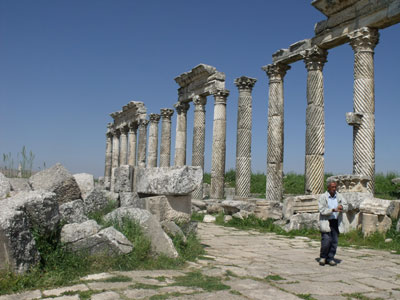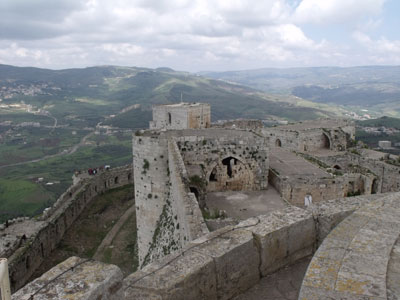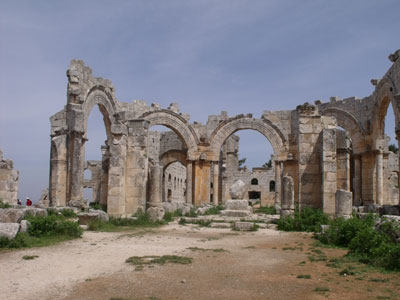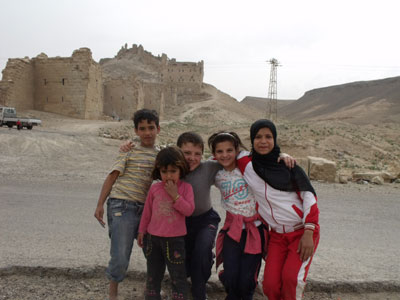Finding a warm welcome in Syria
by Brita Bishop, Dallas, TX
“You are American?” asked the young man behind me in the passport control line at the Damascus airport. “We get few Americans. You will be very welcome.”
The two men checking my passport echoed this sentiment. “American? Welcome, welcome!”
So started an exciting trip to Syria in April 2010.
Often I would think, “I’m really at the Euphrates!” or “I’m really seeing Palmyra!” However, the friendliness of the people is what most impressed me.
I took this trip with Explore (based in Farnborough, Hampshire, UK), booking it through Adventure Center (Emeryville, CA; 800/228-8747). Both our Syrian guide and our Explore leader, a young French woman, were wonderful.
Damascus sights
Our exploration of Damascus started with a walk through the Souk al-Hamadiyeh on the way to the National Museum. Bullet holes in the ceiling of the souk are reminders of the 1925 uprising against the French.
The façade of the National Museum was built using original materials from an eighth-century desert palace that was located west of Palmyra.
I found the paintings from the Doura Europos synagogue to be the museum’s most exciting exhibit. The synagogue had been filled in with sand and, thus, the paintings were well preserved.
We continued on to Saladin’s tomb and the Umayyad Mosque, where the women in our group had to don hooded robes. Before entering the mosque, we each refreshed ourselves with a glass of freshly squeezed orange juice. The mosque, one of the largest in the world, was glorious.
After several more stops and a late lunch, I headed on my own for Damascus’ Christian quarter. I found Straight Street, mentioned in the book of Acts, and from there went to the St. Ananias chapel, said to be the location of Ananias’ house, where Paul stayed after his conversion.
A walk around the city walls brought me to another chapel, the site where Paul was lowered over the city walls in a basket.
I took a taxi back to the hotel. When I gave the driver the hotel card, he kept pointing to his eyes. Finally, it dawned on me: he needed to use my reading glasses!
As is customary on an Explore tour, our leader proposed getting together for dinner, but I was too tired to join them in the Old City, so I walked around the corner from the hotel and found a small café that served chicken wraps and wonderful fresh strawberry juice.
Crusader castles
The next day we toured Krak des Chevaliers, the best-preserved Crusader castle in the world. Sitting dramatically atop Jebel Kalakh, it is a reminder of the Kingdom of Jerusalem, which lasted from 1099 to 1291. Walking around all its passages was fun, and the view from the top was spectacular.
In the afternoon we traveled to Ugarit, a city dating back to 6000 BC and known for the clay tablets found there that were inscribed with what is believed to be the first (cuneiform) alphabet. The site is vast and requires some imagination. Most evident are the numerous water channels once used by the inhabitants, who enjoyed advanced plumbing, including personal bathrooms.
I liked the wildflowers there as much as I did the archaeological remains.
After an overnight in Latakia, Syria’s main port, we saw another Crusader site, Saladin’s Castle. Though less well preserved than Krak des Chevaliers, it is even more dramatically located and larger.
A deep channel around the castle was cut out of the rock, leaving only a solitary pillar that served as a drawbridge support. This must have been a huge feat in the days before dynamite.
Apamea, our final stop before Aleppo, was founded in the third century BC. Military supplies, including 500 elephants and more than 30,000 horses, were kept there.
The beautiful, long colonnade lining the cardo maximus is one of Apamea’s main attractions. Also of interest is a hill crowned by another Crusader castle.
Aleppo
We reached Aleppo that afternoon and started the next day with a visit to the huge Citadel of Aleppo, built in the 12th century. From its top, we had a sweeping view over the city.
Scattered around Aleppo are numerous Dead Cities, or abandoned settlements. St. Simeon, named for the saint who lived there on a pillar for 37 years, is one of them. Its location, on a pine-covered hill, is beautiful.
The pillar is worn down to a big rock, thanks to people’s taking pieces of it. In the baptistery of the church built on the site, our experience was enhanced by the beautiful music of the service, which was delivered in song.
Our guides dropped us off back at the citadel, where, after lunch, I meandered around the souks. When I wanted to go back to the Armenian quarter, where our hotel was located, I got lost. A young man offered to lead me back to the city’s mosque, from where I assured him I could find my way. When I attempted to tip him, he ran away quickly, wishing me a good trip.
I walked the narrow vaulted streets of the Armenian quarter and dropped into St. George’s, a Catholic church. I stayed in the back, as Mass was being celebrated, but the assistant spied me and walked back to wish me “Jesus’ peace.”
The young woman at the hotel desk invited her friends from the English university she attended to meet our group. We thoroughly enjoyed the time chatting with them.
Along the Euphrates
After a stop at Lake Assad and the Euphrates Dam the next day, we arrived in Resafa in a sandstorm. It lent an atmospheric though eerie touch to the ruins there.
The city is built of gypsum and, thus, glitters in the sun. Established by the Romans as a defense against the Persian Sassanids, it was a fortified caravan town on the trade route between Damascus and the Euphrates via Palmyra.
At Halabiye, a two-hour drive from Resafa, I was excited to be able to dip my hands into the Euphrates. Instead of climbing up to Halabiye’s ruins, I observed families picnicking on this Friday, their day off.
Families packed tightly into the backs of colorfully decorated trucks waved at me. Several children ran toward me to get their pictures taken. One girl spoke some English and invited me to their picnic. Her family pulled out a chair and gave me a pastry filled with meat and cooked over charcoal.
We arrived at Deir ez-Zor in the late afternoon and visited the Armenian Memorial Church with its museum chronicling the 1915 genocide. Syria welcomed the refugees back then. Still, an estimated 1.5 million people were killed.
In Doura Europos the next day, we were lucky to run into the head of the French archaeological expedition there. After only a handful of our group members admitted to speaking French, he told us about the dig in excellent English. There we saw the site from which the beautiful synagogue paintings in the National Museum of Damascus had come. However, other buildings of this large Hellenistic fortress city were much more imposing. From the top of the citadel, we had a great view of the Euphrates.
Mari, the most important Mesopotamian city of Syria, was harder to appreciate in its current state. It once had a 300-room palace, of which little remains but some walls that are under protective covering. The sophisticated irrigation system there can still be seen.
A Syrian doing a documentary for the Syrian tourism bureau filmed us as we walked around.
On to Palmyra
On the way to Palmyra we saw the first tourist rest stop in Syria, the Bagdad Café. It was a pleasant place to relax.
In Palmyra, some of the more energetic among us went to see the ruins by night, but I was worn out.
The Palmyra site is huge. The buildings at the site date mainly to AD 200-300.
The next day, after a guided tour, we wandered around on our own, then headed for the spectacular tower tombs up on the hills. The following day we completed our circular tour of Syria, returning to Damascus.
The cost of this nine-night trip was $1,190. I continued on to Jordan for seven days for another $1,000. My flight on United/BMI from Dallas to Damascus through London cost $1,300.





